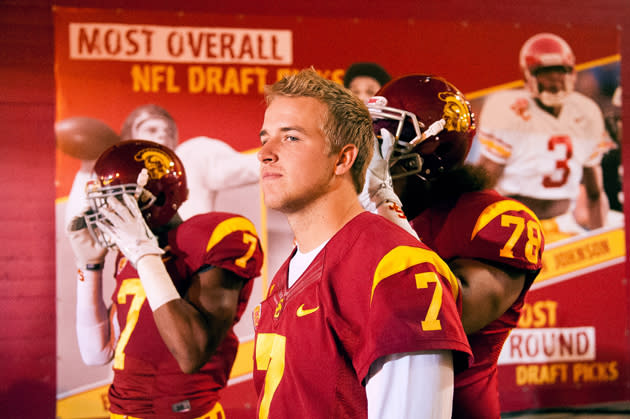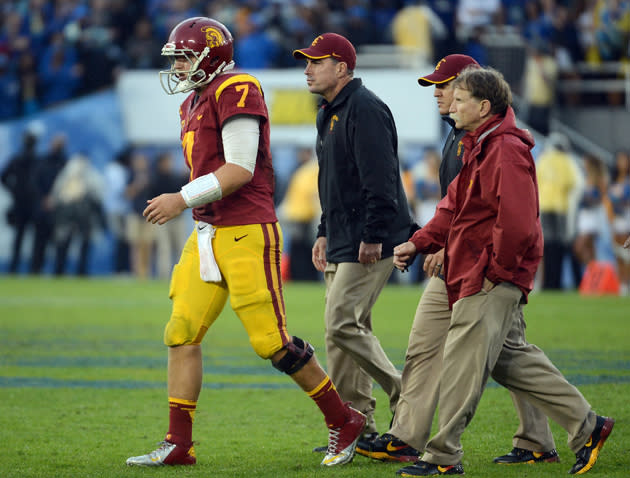Matt Barkley’s best method at pro day and beyond? Acceptance of reality
"A man's GOT to know his limitations." -- Clint Eastwood, as Harry Callahan
LOS ANGELES -- When Matt Barkley starts throwing the ball at USC's pro day on Wednesday afternoon at Cromwell Field, he might be facing more pressure, and have more on the line, than any draft prospect this year. While the spotlight was focused on Notre Dame linebacker Manti Te'o for his pro day on Tuesday, at least Te'o was able to get on the Lucas Oil Stadium turf and do his thing. Barkley was hindered by the remnants of an in-season shoulder injury and could not throw -- leading to more questions than ever about his arm strength, and how his physical measurables will transfer to the NFL.
Those in favor of Barkley as a future star in the pros point to his poise, experience, intangibles, and ability to play well against some of the NCAA's best teams with a high-profile program under recruiting restrictions and bowl bans left over from the end of the Pete Carroll era. Those opposed bring up Barkley's generally underwhelming arm, and the efficiency drop-off he suffered in the 2012 season. Many believed Barkley to be a top-10 prospect had he made himself available for the 2012 draft, but he chose to stick it out another season. He threw 15 interceptions to seven the year before, his completion percentage dropped from 69.1 to 63.6, and though his yards per attempt jumped from 7.9 to 8.5, he did not end his USC career well at all, throwing nine of those 15 picks in his last four games. The Trojans lost three of four to end Barkley's portion of the season, which came to a crashing halt with a separated shoulder against UCLA on November 17.
At the combine, Barkley was under the gun, answering tough questions about everything from his arm strength to his less than imposing senior season, to how ready he'd be for that pro day. When he was asked if he possessed the velocity required for NFL success, you could tell that he'd been hit with that one before, and he was pretty tired of having to deal with it.
[Also: Pro day observers: Manti Te'o not worthy of first-round draft pick]
"I would disagree," Barkley said, when one reporter questioned his NFL-caliber arm talent. "Look at the tape. Watch the tape. I’m not going to go through certain throws, but you can watch the tape where I’ve made throws in tight windows. I can make every NFL throw that you need. So I would disagree ... I’ve thrown with great velocity, deep balls, already. I wouldn’t say I’d be able to play a complete game right now, but I feel confident that everything’s going to be fine, if not better than normal. With all the back, scapula, rotator-cuff movements and exercises that I’ve been doing, I’ll be better than I was before the injury."
Now, there's nothing left but to prove it. But how much can Barkley really prove? Most likely, he'll take the work he's been doing with quarterback guru Chris Weinke at the IMG Academy in Florida and bring it to the field in a scripted session that will include approximately 64 passes. He'll throw to Robert Woods, his longtime classmate who is also trying to make his name in this draft class, and he'll most likely complete over 60 throws. He'll show his estimable ability to throw on the move, and he'll put as much sauce as he possibly can on deep throws -- to prove that he can, and to shut people up.
One of the most important and undersold aspects of Barkley's pro day will be after the official throwing session is complete. At his 2009 USC pro day, Mark Sanchez worked with the Detroit Lions' coaching staff following his official session, and he willingly made as many extra and specific throws as the coaches could have wanted. Without that extra credit, one wonders if the New York Jets, or any other team, would have traded up to select him, or if such a demand could have been created -- even artificially.
Barkley was defiant about his arm strength at the scouting combine, which I like even though I completely disagree with his self-evaluation. You want a quarterback to stand up for himself when people are doubting him -- especially as he transitions to the NFL, a league that will kick his ass from time to time no matter how physically gifted he is.
That said, Barkley's physical limitations show up on tape, and they do so more often than not. He is unable to consistently make stick throws into tight windows when throwing 20 or more yards downfield, and he struggles to consistently complete throws against his body to the sideline before coverages converge. He has great touch on most of his passes, which means that he's learned adaptive strategies in order to transcend those physical limitations. And the most important word in that paragraph is consistently -- even the most noodle-armed quarterback will occasionally cork one off, but NFL teams with vertical offenses require that their quarterback make those throws over and over with minimal effort.
[Report: Seahawks may have multiple trade partners for Matt Flynn]
And with all that, there's no certainty that Barkley will be some sort of epic failure in the NFL. Even if his limitations define him, Barkley has the same opportunity given to Sanchez, and to Alex Smith, and to Matt Hasselbeck, and to many quarterbacks before them -- the opportunity to run the playbook in the right system for his unique abilities.
Bart Starr helped the Green Bay Packers win five NFL championships and two Super Bowls, and nobody would have mistaken him for Sonny Jurgensen, the universally-acknowledged best arm of his generation. Joe Montana captained his San Francisco 49ers to four Super Bowl wins with an arm so "deficient," his team didn't even run its passing plays on a regulation-sized practice field. Why is this, John Madden once asked Montana. We don't run plays longer than 40 yards, Montana replied. These players were able to maximize their strengths and minimize their weaknesses because they and their coaches had intimate understandings of both.
As Montana once famously said, "I don't throw darts at balloons; I throw balloons at darts."
Matt Barkley would do well to start throwing as many balloons as possible, and forget about the darts except in case of emergencies. He can still succeed in the NFL without trying to become what he's not. In fact, that's his only real path to success.
"Barkley seems to think he has to show people he possesses a stronger arm and is more accurate than some assume -- and he's confident he can achieve both feats," former Dallas Cowboys personnel executive Gil Brandt recently wrote on NFL.com. "We spoke for a while, and I came away impressed with his positive attitude and determination to prove the naysayers wrong. He told me the shoulder he injured last season feels great and that he doesn't have any excuse to not do well."
That's all well and good, and while Barkley does impress with his intangibles (he also reportedly nailed his team interviews at the combine), he's preaching to the congregation. Few would question Barkley's in-game intelligence, toughness, or leadership characteristics. Most people who have analyzed the situation understand that Barkley's statistical downturn in 2012 as not his fault alone. There was the shoulder injury, there was head coach Lane Kiffin's questionable (at best) playcalling -- Kiffin rarely put USC's offense in positions to succeed with multiple receiver sets in obvious passing down -- and there was the fact that USC's porous defense put Barkley under an additional amount of pressure. Not to mention that Marqise Lee, his most talented receiver, was freelancing routes more than he should have been.
The extenuating factors merely reinforce the primary issue some have with Barkley -- the simple fact that other, better quarterbacks have been able to transcend such issues. Robert Griffin III won the 2011 Heisman Trophy despite the fact that he was every opponent's primary focus, and the Baylor defense was a slapstick nightmare through most of Griffin's time as a starter. Put simply, the best guys shake those things off and kill you anyway, and Matt Barkley simply isn't one of the best guys. That's not a fatal indictment of his NFL potential -- just a reminder and realization that he will need things to work well around him. There's nothing wrong with that, but this isn't going to be the aforementioned Griffin, or Andrew Luck redefining a dumpster fire of a passing offense in Indianapolis, or Russell Wilson quite possibly making his mark as the Seattle Seahawks' best franchise quarterback in his rookie year.
Matt Barkley is a cog, not a superstar. There's nothing wrong with that, as long as everybody involved understands the parameters and limitations. Starting with Barkley himself. He can throw a bunch of relatively innocuous deep stuff in short and shorts with nobody bearing down upon him, but NFL teams will leave L.A. and head straight back to the tape. What they find there will define Barkley's future. What he can really do on Wednesday is to prove that the shoulder works just fine ... and possibly find himself in the first round at the end of April.
College basketball video from Yahoo! Sports:
Other popular content on Yahoo! Sports:
• Reseeding the Sweet 16 | Play Second Chance Tourney Pick'em!
• Top seeds L'ville, Kansas in the way of All-Big Ten Final Four
• Denny Hamlin out at least five races because of back injury
• Lakers' Metta World Peace has lateral meniscus tear in his knee

 Yahoo Sport
Yahoo Sport 









































